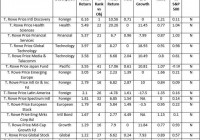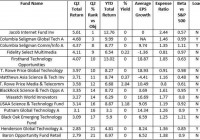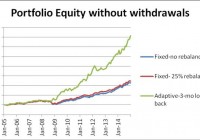Best Performing T. Rowe Price Mutual Funds Of Q2 2015
The best second quarter performer from a T. Rowe Price (NASDAQ: TROW ) mutual fund was not robust, but sufficient in a tough quarter where broader markets struggled to maintain a seat in the positive zone. Though T. Rowe Price’s best gain of 6.2% lagged key players like Fidelity , PIMCO and Franklin/Temp , the fund family managed to post better gains than peers including Oppenheimer (NYSE: OPY ), Lord Abbett and Vanguard Group. T. Rowe Price’s quarterly gain is short of the second quarter’s top performer the ProFunds UltraChina (MUTF: UGPIX ) which managed a gain of almost 16%. Also, gains look very modest going beyond the top 10 of the T. Rowe Price performers. However, if we look at broader markets then we do notice the dismal trend. There were only 15 funds (excluding same funds of different classes) that could post above a 10% gain in the second quarter, reflecting the muted quarterly performance. Also, only four of the mutual fund categories could post above a 10% gain in the first half. Just 41% of mutual funds could manage to finish in the green in the second quarter. This is less than half of the 81% gains scored by mutual funds in the first quarter. These losses however owed a lot to the selloff on the eve of the quarter’s end. Of the 181 T. Rowe Price mutual funds under the study, 98 funds finished in the green while 2 funds, the T. Rowe Price Global Allocation Fund (MUTF: PAFGX ) and the T. Rowe Price Institutional Global Growth Equity Fund (MUTF: RPIGX ), had a break even return. Average gain for the 98 funds stood at 1.04%. The other 79 funds ended in the red with an average loss of 1.22%. Only 6 funds had above 5% loss, with the largest loss reaching 9.95%, coming from the T. Rowe Price Real Estate Fund (MUTF: PAREX ). (Note: This number includes funds from same classes). T. Rowe Price’s Second Quarter Wrap Up T. Rowe Price notes that Greek debt crisis concerns had offset the “resilient corporate earnings growth and enthusiasm about a reaccelerating U.S. economy” to drag Dow down to the red in the second quarter. Among the major benchmarks, small caps outperformed while mid caps had the worst performance. Winter Slowdown is Momentary : T. Rowe Price Chief U.S. Economist Alan Levenson noted that the winter effect was partly to be blamed. However, while winter caused some hiring weakness and the West Coast ports strike added to concerns, job growth gathered steam in April and May. While initial claims had dropped to a 15-year low, wage gains and consumer spending also reflected strong trends. Timing of the Fed Rate Hike : The winter effect had pushed back expectations for the first rate hike. The Fed minutes from the April’s policy meeting noted that the winter effect made it “unlikely” for Fed to raise rates in June. The number of members anticipating rate hike increased in June meeting. Greece : The quarter ended on a dismal note largely due to the Greek debt concerns. Greece and its creditors continued negotiations about the repayment of debt. Greece had proposed bundling several debt repayments to the IMF. On Jun 29, US markets had the steepest daily decline since Oct 2014 as Greece shut down banks and the stock market. Top 15 Gainers of Q2 2015 T. Rowe Price is one of the world’s leading investment management companies. Founded in 1937 by Thomas Rowe Price, Jr, the company offers a wide range of mutual funds, sub-advisory and separate account management services for both individual and institutional investors. It relies on fundamental research and a disciplined approach to provide a full range of investment strategies. The company’s strict adherence to stated investment objectives ensures the long term integrity of its client portfolios. Below we present the top 15 T. Rowe Price funds with best returns of Q2 2015: (click to enlarge) Note: The list excludes the same funds with different classes, and institutional funds have been excluded. Funds having minimum initial investment above $5000 have been excluded. Q2 % Rank vs Objective* equals the percentage the fund falls among its peers. Here, 1 being the best and 99 being the worst. The trend emanating is that a diversified group of funds has managed to feature in the top 15 performers’ list. Though there is yet again a domination of foreign funds, they are from varied regions. The top gainer the T . Rowe Price International Discovery Fund (MUTF: PRIDX ), and funds such as the T. Rowe Price International Growth And Income Fund (MUTF: TRIGX ) and the T. Rowe Price Global Stock Fund (MUTF: PRGSX ), invest in non-US instruments and are not restricted to particular regions. The diversity is also prominent from other funds such as the T. Rowe Price Japan Fund (MUTF: PRJPX ), the T. Rowe Price Emerging Europe Fund (MUTF: TREMX ), the T. Rowe Price European Stock Fund (MUTF: PRESX ), the T. Rowe Price Latin America Fund (MUTF: PRLAX ) and the T. Rowe Price Africa & Middle East Fund (MUTF: TRAMX ). International bond fund, the T. Rowe Price Emerging Markets Corporate Bond Fund (MUTF: TRECX ) also made it to the list. Here, PRIDX, PRGSX and TRECX carry a Zacks Mutual Fund Rank #1 (Strong Buy) . TRIGX has a Zacks Mutual Fund Rank #2 (Buy) . While PRJPX holds a Zacks Mutual Fund Rank #3 (Hold), PRLAX and TRAMX carry a Zacks Mutual Fund Rank #4 (Sell) and a Zacks Mutual Fund Rank #5 (Strong Sell). Among the other categories, Health, Financial, Technology and Growth funds were also among the top 15 gainers. These included the T. Rowe Price Health Sciences Fund (MUTF: PRHSX ) from Healthcare category, the T. Rowe Price Financial Services Fund (MUTF: PRISX ) from the T. Rowe Price Global Technology Fund (MUTF: PRGTX ) and the T. Rowe Price Media And Telecommunications Fund (MUTF: PRMTX ) from Tech category, and the T. Rowe Price Mid-Cap Growth Fund (MUTF: RPMGX ) from growth category. PRHSX, which carries a Zacks Mutual Fund Rank #2, was also one of the best performing healthcare mutual funds of Q2 2015 . Also, both PRGTX and PRMTX were among the best performing technology mutual funds of Q2 2015. Link to the original article on Zacks.com


